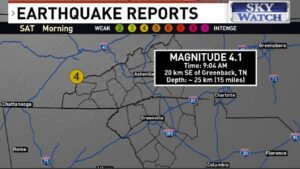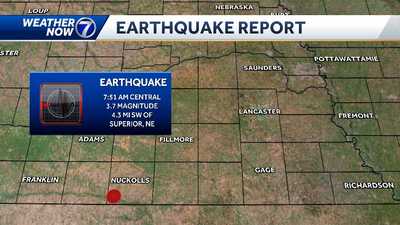Earthquake Report: 3.7 Magnitude Quake Rattles Superior, Nebraska
According to the United States Geological Survey (USGS), a magnitude 3.7 earthquake struck southern Nebraska early Sunday morning, June 1, 2025. The quake occurred at approximately 4:51 a.m. Central Daylight Time and was centered 4.3 miles southwest of the city of Superior, Nebraska, near the Kansas state line. Though Nebraska is not known for frequent seismic activity, the event was felt by numerous residents in the surrounding region, raising awareness about the area’s geological vulnerabilities.
Epicenter and Seismic Details
The earthquake originated at a shallow depth of approximately 2.5 miles (about 4 kilometers) beneath the Earth’s surface, according to data from the USGS. Shallow earthquakes typically have a greater potential to be felt on the surface, even when they are of lower magnitudes. Despite the relatively modest 3.7 magnitude, the tremor was perceptible in various nearby communities, including parts of Kansas.
Residents in and around Superior described the quake as a sudden, brief jolt followed by subtle rumbling. Many reported hearing a low-frequency sound that preceded or accompanied the shaking. Windows rattled, picture frames shook, and some small household objects were displaced. However, there were no immediate reports of structural damage or personal injuries.
Geological Background
Nebraska sits within the interior of the North American tectonic plate and is far from the more seismically active boundaries along the Pacific Coast. However, the region is not entirely free from tectonic stress. Southern Nebraska and northern Kansas are part of a geologically complex area influenced by ancient fault systems, including the Midcontinent Rift and the Nemaha Ridge.
The quake’s epicenter lies near the Kansas Uplift Fault Zone, a relatively stable but not inactive fault system. Although not as seismically active as places like California or Alaska, this part of the Midwest has experienced minor earthquakes historically. For example, Nebraska’s strongest recorded earthquake occurred in 1935 near Tekamah and measured 4.3 in magnitude.
The USGS and other geological monitoring agencies continue to study these intraplate fault systems to better understand the nature of seismicity in the region. Events like the June 1 quake contribute valuable data to these ongoing research efforts.
Community Response
While the quake did not cause significant damage, it served as a wake-up call for many local residents. Emergency services in Nuckolls County, where Superior is located, received several phone calls from concerned citizens, though no emergency assistance was required. Local officials conducted brief inspections of infrastructure, including roads, bridges, and public buildings, and reported no abnormalities.
The Nebraska Emergency Management Agency (NEMA) issued a brief statement advising residents to remain calm and to stay informed through official channels in case of aftershocks. Although aftershocks are more common after stronger earthquakes, they can still occur after moderate events like this one.
Public Reaction and Awareness
On social media, residents quickly shared their experiences. Some described being jolted awake by the shaking, while others posted photos of minor disturbances in their homes, such as shifted books or off-kilter frames. The incident sparked conversations about emergency preparedness in an area where many residents have never experienced an earthquake.
Schools in the area, including those in the Superior Public Schools district, took the opportunity to review earthquake preparedness plans and reassured parents that facilities had been checked and deemed safe.
Importance of Preparedness
Although Nebraska is not considered a high-risk earthquake zone, this event highlights the need for public awareness and preparedness even in areas with low to moderate seismic activity. Earthquakes, by nature, occur with little or no warning, so having basic knowledge of safety protocols can significantly reduce the risk of injury or panic.
The Federal Emergency Management Agency (FEMA) recommends the “Drop, Cover, and Hold On” method during earthquakes. People are also advised to secure heavy furniture and electronics, store an emergency kit with essential supplies, and develop a communication plan with family members.
Looking Ahead
Seismologists do not expect significant follow-up activity related to this event, but ongoing monitoring will continue in the days ahead. The USGS encourages residents who felt the quake to submit a report through their “Did You Feel It?” tool, which helps scientists better map the distribution of ground shaking.
In conclusion, the magnitude 3.7 earthquake near Superior, Nebraska, on June 1, 2025, was a moderate but notable event for the region. It caused no major harm but served as a timely reminder that earthquakes can and do occur in unexpected places. With increasing access to seismic monitoring and emergency education, residents can be better equipped to respond calmly and effectively in the future.













